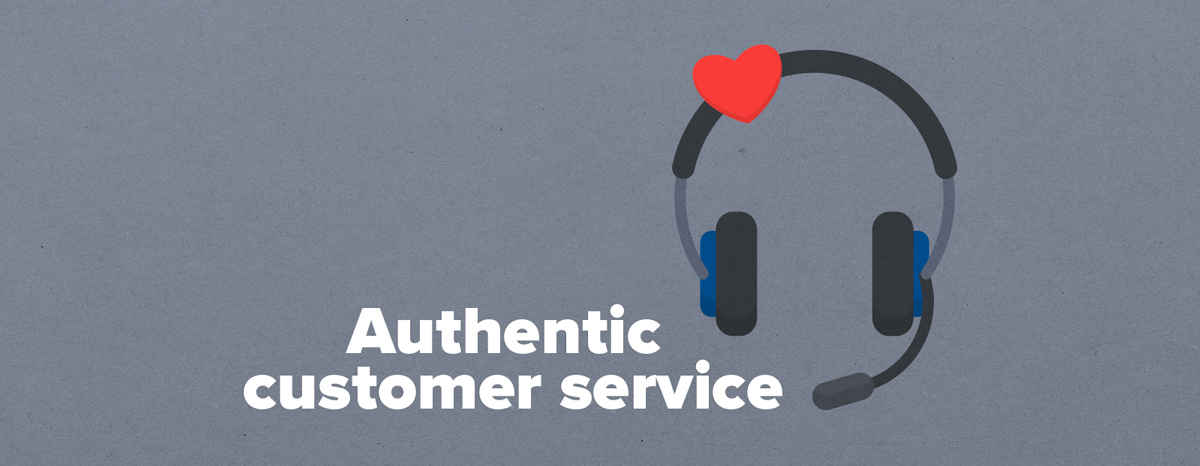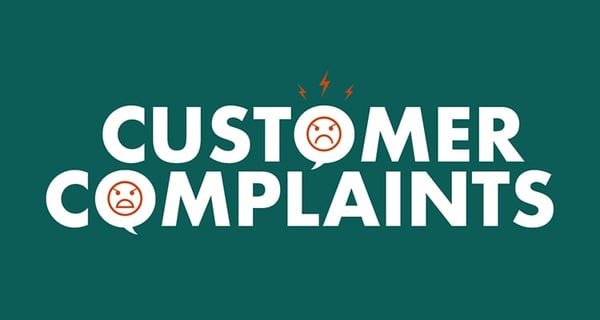Post summary:
- Quality trumps speed
- Why human's love to share bad experiences
- 5 must-have skills for authentic customer service
Think of the worst customer service experience that you have had recently.
Now let me ask you. How did you feel?
Did you feel like your business didn’t matter?
Like no one cared? Or that you were just a number?
I know I did.
In 2014, I shared my horror story with a very well-known online travel company. I was booking a flight for my family of 13 people who would be traveling from the US to Europe. It took a lot of time, effort and research to put together the itinerary so that everyone could fly together and at the same time.
One month before we were to travel, the whole itinerary was turned upside down.
I used days to try and fix the situation.
I was constantly transferred from one department to another. I had to explain and re-explain my situation to each customer service agent only to be hung up on after waiting for hours.

And just like we found in our recent Customer Service Benchmark Report, no one responded to my emails and requests for help. Each agent sounded and acted like a robot. The only thing I felt like they wanted to do was to quickly close the issue move on to the next call in line.
It’s human nature to spread a bad customer experience
I am not alone in my reactions to a poor customer service experience.
Research shows that not only are customers willing to stop doing business with you because they’ve received poor customer service, but they are more than willing to share their bad experience with others.
And share they will.
In a 2013 survey of 1,000 individuals, Dimensional Research found 95% of respondents who have had a bad experience said they told someone about it, compared to 87% who shared a good experience. In fact, bad experiences were more likely to be shared in multiple circles.

Thanks to social media, almost 60% of the respondents were more likely to tell others about their customer service experiences now than 5 years ago. And those that had bad customer service experiences shared their story more than 5 times.
Why do we focus on the negative more than the positive?
People are emotional beings
In a 2015 study of 45,000 US consumers, Forrester Research found that emotion, how an experience makes the customer feel, matters more to customer loyalty than effectiveness or ease. In fact, emotion was the #1 factor in customer loyalty across 17 of the 18 industries studied.

Consider these facts from New Voice Media:
- 53% switch suppliers because they feel unappreciated.
- 42% switch suppliers because they are put off by rude or unhelpful staff.
- 32% switch suppliers because they are fed up with speaking to multiple agents.
Humans are wired to remember negative experiences more than positive ones.
Clifford Nass, a professor of communication at Stanford University said, “This is a general tendency for everyone. Some people do have a more positive outlook, but almost everyone remembers negative things more strongly and in more detail.” (Tweet this!)
“The more emotionally disturbing the experience is to us, the more likely we are to commit it to memory,” confirms Elisabeth Kensinger.
The ability to remember even the smallest details surrounding a tragic or traumatic event is directly related to the intensity of the event itself because memory and emotion are linked in the brain.
So don’t be fooled into thinking that a bad customer experience will eventually become water under the bridge because it won’t. People remember the bad and it has negative consequences.
Quality trumps speed
In our fast-paced world where money is time and time is money, many companies equate better service with faster service.
Companies measure the quality of their service by the number of calls or emails in the customer service queue, how fast they’re able to respond to inquiries and how fast the inquiry was closed.
But does fast service trump quality and attitude? Apparently not.
A Gallup study reveals that enduring relationships result only when companies pay attention to meeting the important emotional needs of their customers, not just providing faster service.
Here’s some research to take note of:
In a study conducted for a banking client, Gallup researchers found that the level of engagement felt by the bank's customers was affected by the speed with which these customers were served. Customers who felt that the bank offered exceptionally speedy service were 6x more likely to be highly engaged.
However, customer perceptions of the tellers' courtesy and their apparent willingness to help were far more important than speed of service in generating customer engagement. Customers who gave the bank high ratings on those "people" attributes were 9x more likely to be fully engaged.
Research from RightNow's Customer Experience Impact study also supports this finding. When consumers were asked why they might switch to a competitor, the number 1 reason was due to “rude, incompetent staff” which was 18% more than “issues weren’t solved in a timely manner.”
Customers don’t want to talk to robots.
In a 2010 survey of 517 US consumers, Genesys found 40% of people prefer better human service over other types of assistance.

Better human service has more to do with soft skills than hard skills.
Wait a second… Soft skills. Hard skills. What are those?
5 must-have skills for authentic customer service
Skills which are required for technical and operational actions are called hard skills. Hard skills focus on the systems, tools and methods used to deliver your products and services to your customers.
Soft skills have to do with the personal side of service and go straight to a customer’s emotional reflex in the brain.
For example, customers are affected by how you greet them in person or on the phone, how you listen to them, and the warmth and sincerity in your voice when talking to them. These skills have the opportunity to cause, positive, negative, or indifferent reactions.
At the end of the day, customers will remember how you made them feel. And so it’s the soft skills, more than technical skills, that make the difference between an average customer service professional and the one who can make customers feel fantastic about the help they got from your company.
Here are the top 5 emotional skills to provide authentic customer service in order to make your customers feel special and fall in love with your business:
1. Empathy
Customers don’t want to talk to people who respond like robots and show no emotion.
Research by Eptica found that one of the biggest complaints consumers have is that when they raise an issue with a company, customer service agents don’t show any understanding or sympathy for their situation.
What exactly is empathy?
According to Customer Service Reader empathy is about “sensing others’ feelings and perspective, and taking an active interest in their concerns.”
People with this competence:
- listen well
- show sensitivity and understand others’ perspectives
- help out based on understanding other people’s needs and feelings.
When a customer comes with a problem, it’s very easy to jump right into data gathering. We ask for name, company, request number, date of purchase and a slew of other questions.
Although this approach is technically correct, it actually feels more like an interview, or worse yet, an interrogation.
One way of drastically improving the customer experience is to show empathy and compassion.
Spotify shows it cares through customer playlists. If you’ve got a question for Spotify, not only will it answer you, it will answer you with a song or a customized playlist.

So the next time before you start data gathering and problem solving, take a few minutes to create a rapport with the customer so that he can feel more at ease.

Here are 7 phrases that convey empathy to customers:
- “I can understand how frustrating it is when your Widget breaks down.”
- “I realize how complicated it is to…”
- “I cannot imagine how upsetting it is to…”
- “I know how confusing it must be when…”
- “I’m so sorry to hear that…”
- “I hate that you had to make this call today.”
- “I’m glad you called today so that we can take care of this right away.”
2. Positivity
As a skill in customer service, positivity refers to the use of positive language when communicating with customers, whether in verbal or written form.
Negative language in verbal or non-verbal form has a very strong impact.
According to psychologists Mark Waldman and Andrew Newberg, the sight of a negative word like “no” for less than a second or seeing a list of negative words for a few seconds can release dozens of stress-producing hormones in the brain.
When it comes to verbal communication, their research shows that if you vocalize your negativity, or even slightly frown when you say “no,” more stress chemicals will be released, not only in your brain, but in the listener’s brain as well. The listener will experience increased anxiety and irritability, thus undermining cooperation and trust.
Consider these examples of negative language and what they really mean:
- Unfortunately…(I’m about to tell you some bad news)
- Yes, but….. (I don’t agree and I’m about to tell you that you’re wrong)
- We can’t see how…(you’re not very smart)
- We must ask you to….(if you don’t do this, I won’t help you)
Negative phrases immediately put someone on the defensive.
On the other hand, the way we positively phrase something can have a big effect on how the service is perceived.
Try these positive phrases on for size:
- What can I help you with today?
- If you can send us (x), we can complete the process for you.
- The information we have suggests that you have a different viewpoint on this issue. Let me explain our perspective
- Might we suggest that you (suggestion).
- One option open to you is (option).
- I’m so glad to be of help…
3. Active listening
Stephen R. Covey said, "Most people don’t listen with the intent to understand; they listen with the intent to reply." (Tweet this!)
How many of us have been guilty of this at one time or another?
Customers contact customer service because they need help with something and they also want someone to listen to their explanation
Scripted responses and generic answers don’t show the customer that you care. Instead, it just feels impersonal.
Active listening is a gift of time and appreciation for the person who is speaking. It shows the other person that she’s important enough for you to give her your full attention.
How do you actively listen?
Here are a few tips:
- Focus on the customer and erase everything else from your mind. It might help to pretend that the person you’re speaking with on the phone is sitting right across from you. Pay particular attention to details like tone, word usage, and voice volume. This will help you to navigate the conversation better.
- Ask questions to help clarify your understanding of the problem. This reassures the customer that you’ve been paying attention and that his issue will be handled. For example, if a customer is having issues with a new laptop the agent could say, “You said earlier that your laptop turns off unexpectedly, but reboots ok – is that correct?”
- Listen for key feelings because feelings are just as important as facts. When you notice how customers are feeling, it gives you some idea of how to best handle the call. If the customer seems short on time, you could tell him how long it will take to complete the request so that he knows exactly how much time is needed. If the customer seems upset, then take the time to let him vent his frustration and calm him down before you begin handling the request.
4. Friendliness
Friendliness is a top-rated customer service trait. Research from Ask.com supports this claim. In a poll of 2000 users, the company found that 48% of users reported that “friendly” was the most important quality in customer service.
What’s friendly customer service?
Well, first, it’s a smile.
Friendly people smile and they smile more often. A smile is a powerful tool in the customer service toolbox. And just because you’re on the phone, don’t think that the person on the other line can’t hear the smile because he can.

Here’s something to try.
Keep a mirror up by your desk close to the phone. Before you pick up your next call, look into the mirror and make sure to smile before answering. The mirror will also help you to remember to smile throughout the whole conversation.
Thank your customers for calling. Address them by name and tell them your name at the beginning of the conversation.
Next time, try: “Thank you for calling (your company). My name is (X), how may I help you today?”
Talk to your customers as you would a person. Don’t treat them as just the next number in line.

Buffer does this really well on Twitter, ensuring all customer service requests are answered in a timely manner with a friendly and personal response, signed by the employee who’s doing the tweeting.
5. Patience
Patience is more than a virtue. It’s a must-have skill when it comes to delivering good customer service.
Let’s face it.
You will deal with angry customers.
You will be put in frustrating and sometimes very aggravating situations.
You will need to give more attention to some customers to help them understand some things.
And handling all these situations in a calm, cool and collected manner is part of providing great customer service.
Always handle the customer with respect no matter how difficult the situation.
The most important thing is to listen and try to get to the root of the matter and find a solution.
And the worst thing you or anyone on your team can do is to lose your cool. So don’t!
Conclusion
There you have it!
Five essential customer service skills you need to provide authentic service.
Authentic customer service isn’t just about answering requests as fast and efficient as you can (like it was in the good ol’ days!). Customers want to be treated as more than just a number. We, as people, want more than that. We all want to be acknowledged, appreciated and heard. It’s a part of human nature.
Any company that wants to stay in business knows that they need to handle customer requests in a fast and efficient way.
But, for those that really want to stick out from the crowd and give their customers that certain “je ne sais quoi”, add an emotional element into every customer service interaction - a friendly smile, a calm voice and a positive outlook, which in addition to a fast and efficient service is all it takes to move your customer service from good to great.
What tips do you have for providing authentic customer service?
P.S. If you got something valuable from this blog post, remember to tweet about 5 Essential Skills you Need to Provide Authentic Customer Service!



